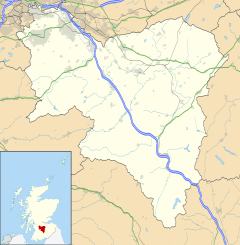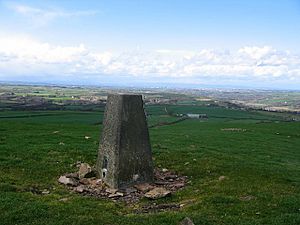Black Hill (South Lanarkshire) facts for kids
Quick facts for kids Black Hill |
|
|---|---|
| OS grid reference | NS 831 435 |
| Council area | |
| Country | Scotland |
| Sovereign state | United Kingdom |
| Post town | LANARK |
| Postcode district | ML11 |
| Police | Strathclyde |
| Fire | Strathclyde |
| Ambulance | Scottish |
| EU Parliament | Scotland |
Black Hill is a special place in South Lanarkshire, Scotland. It is owned by the National Trust for Scotland, a group that protects important places. This hill looks out over the beautiful Clyde Valley. It's home to ancient secrets, including a burial mound from the Bronze Age and a fort from the Iron Age.
Discovering Black Hill
Black Hill is about 2 miles (3 km) east of Blackwood. It sits high above the Clyde Valley near Kirkfieldbank. The hill reaches a height of 290 meters (or 951 feet). At its very top, you'll find a special marker called an ordnance survey triangulation point. This point helps mapmakers measure distances and heights accurately.
From the top of Black Hill, you can see amazing views. On a clear day, you might spot Goat Fell on the island of Arran. You can also see the Cobbler and Ben Lomond, which are famous mountains. Parts of the Southern Highlands are also visible from this historic spot.
A Viewpoint Through Time
People have known how important Black Hill is for a very long time. For over 4,000 years, it has been a valuable place to look out from. Today, you can still clearly see the shapes of the old Iron Age fort. You can also see where people lived inside its walls. The Bronze Age burial mound is also easy to spot.
These early people might have thought Black Hill was a spiritual place. Some believe the burial mound was built to line up with a larger one on Tinto Hill. This might have helped them figure out the date of the Winter solstice. The Winter solstice is the shortest day of the year.
Protecting History
Because Black Hill is so important, it was made a Scheduled Ancient Monument in 1969. This means it is a nationally important archaeological site. It is protected by law to make sure its history is preserved for future generations.



